Beyond the Screen: How AR in Healthcare is Shaping Tomorrow
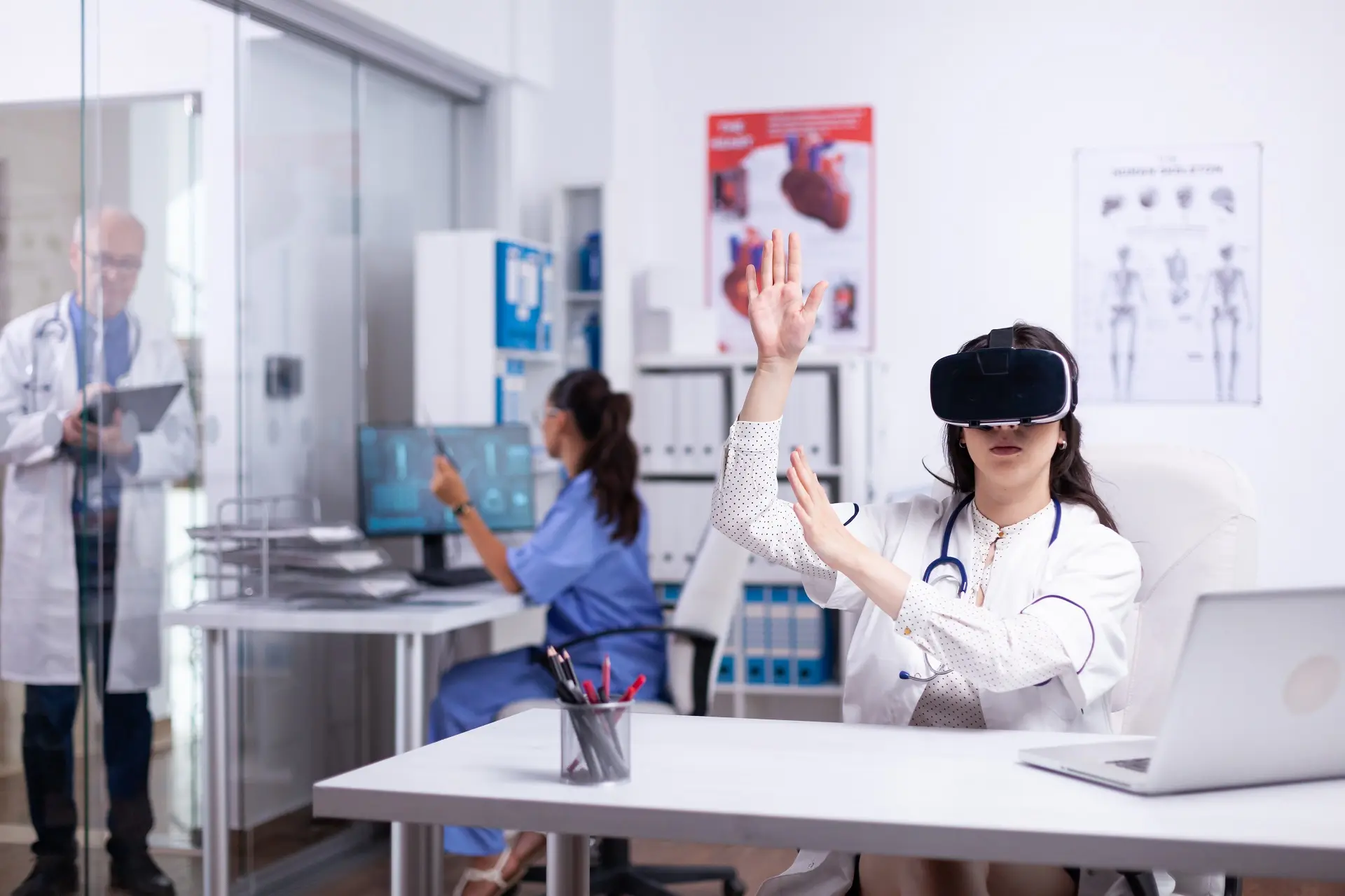
The future is here, and it wears a face of innovation and precision, thanks to AR in healthcare. The market flourishes and will reach $597.54 billion by the end of this decade. In the healthcare sector, AR growth is even more phenomenal. From a humble $2.4 billion in 2022, it’s predicted to skyrocket to $14.07 billion by 2032.
You’ve probably heard a lot about the AR applications in the medical industry. And it’s not surprising, as this technology promises colossal improvements in treatment quality, surgical accuracy, and collaboration among medical professionals. Yet, this is just scratching the surface, and we are here to delve deeper into this topic.
In this blog post, we will tell what is AR in healthcare and how the changes that are already on the horizon will remodel healthcare. Drawing from our rich background in developing healthcare solutions, we at Relevant want to share the latest insights garnered from our experience.
What is AR Technology, and How Does it Work?
Initially finding its footing in the gaming industry, Augmented Reality (AR) has since blossomed and become one of the key healthcare technology trends. AR blends the physical and digital worlds to create experiences that are more immersive and interactive. But to grasp the depth of its impact, we first need to understand what is augmented reality in healthcare and how it operates.
AR in the healthcare industry, just like in any other, overlays digital elements, such as images, videos, or sounds, onto the physical surroundings using smartphones, tablets, AR glasses, contact lenses, and other devices. What drives the adoption of augmented reality in the healthcare industry is the need for data visualization. For example, AR facilitates the projection of computerized tomography and magnetic resonance imaging of data in a stereoscopic way during surgeries, offering the unparalleled precision so vital for medical professionals. The healthcare use cases are vast, and we will review them all later in the article.
The Working Mechanism of AR in Healthcare
AR requires a set of components to operate, including:
- Cameras and sensors scan the physical environment to gather information and identify the areas where the AR elements will be placed.
- Processor. Much like a computer’s CPU, it processes the data and works out the logistics of where and how to display the AR elements.
- Display, be it a smartphone screen or AR glasses, showcases the augmented elements, merging them with the real-world view.
- Input devices allow users to interact with the augmented elements. It’s possible to use touch screens, gesture controls, or voice commands.
- AR Software is the heart of the system. It analyzes the data from the camera and sensors to generate and position the augmented elements in the correct 3D coordinates in the real world.
The Difference Between AR, VR, MR, and MX
All these terms represent different technologies that offer various immersive experiences. Each one, while interconnected, offers a distinct approach to blending the digital and physical worlds. Let’s break down these terms one by one, with a special focus on AR and VR in healthcare.
Augmented Reality (AR)
So, as we already know, AR adds digital elements to the live view of your physical environment, typically seen through a smartphone or AR glasses. Those digital elements can involve additional information, graphics, or other digital data. AR offers substantial benefits, providing doctors with real-time data and visual aids during surgeries or diagnostics.
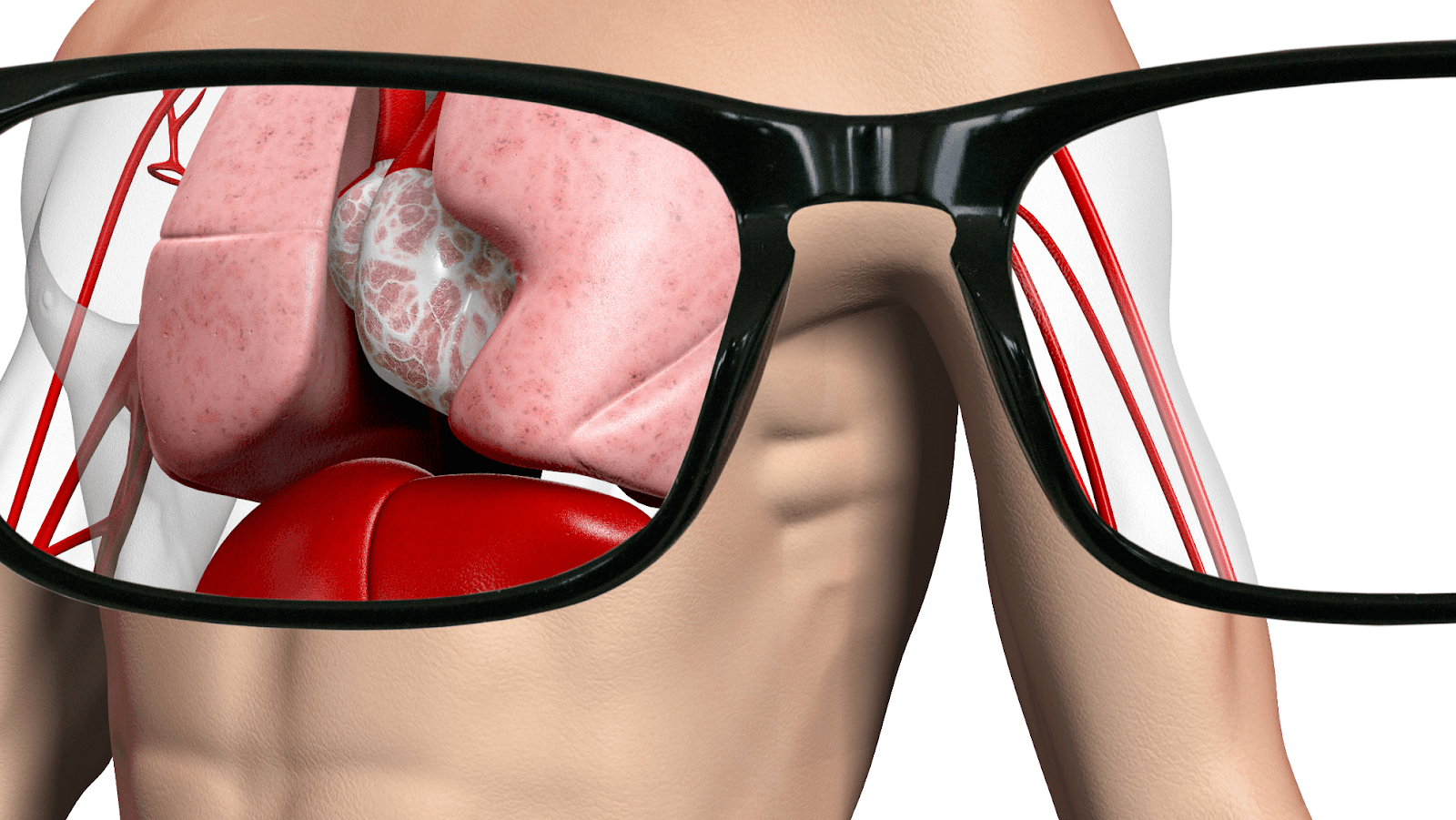
Virtual Reality (VR)
Virtual Reality, or VR, takes it a step further by creating a completely virtual, computer-generated environment. Users can immerse themselves in a different reality, often using VR headsets. In healthcare, VR can create simulated environments for medical training, therapy, and rehabilitation, holding the huge potential of AR/VR in healthcare. Also, VR is used by digital twins in healthcare to create a dynamic, virtual replica of physical systems, providing a real-time, immersive visualization for healthcare professionals to optimize diagnostics and patient outcomes.
Mixed Reality (MR)
Mixed Reality, abbreviated as MR, combines elements of both AR and VR. It enables digital and physical objects to coexist and interact in real-time, offering a more immersive and interactive experience. It represents an entirely new way we interact with computer systems and digital environments.
Extended Reality (MX)
Extended Reality, referred to as MX, is an umbrella term that includes all immersive technologies — AR, VR, and MR, along with new approaches that are still in development. It covers the entire spectrum of experiences that blend the physical and digital worlds, aiming to create more integrated and immersive experiences.
If you’re interested in emerging technologies and their real-world applications in medicine, you can check out our article about IoMT solutions.
Benefits of Implementing AR in Healthcare
The integration of AR in healthcare offers a deeper understanding and a more hands-on approach to health and wellness. How exactly and what are the concrete benefits of augmented reality in healthcare? Read below.
Enhanced Learning Experience in Medical Training
AR apps bring the complexity of human anatomy to life and offer students a 3D canvas to explore and learn the intricacies of the organs with a depth that ordinary textbooks cannot provide. They can get hands-on learning experience, where every layer of the human body can be sliced and studied in detail. Moreover, AR solutions allow for real-time feedback and interaction, which means medical institutions can create a dynamic learning environment that will help students grasp concepts more quickly and retain them longer.
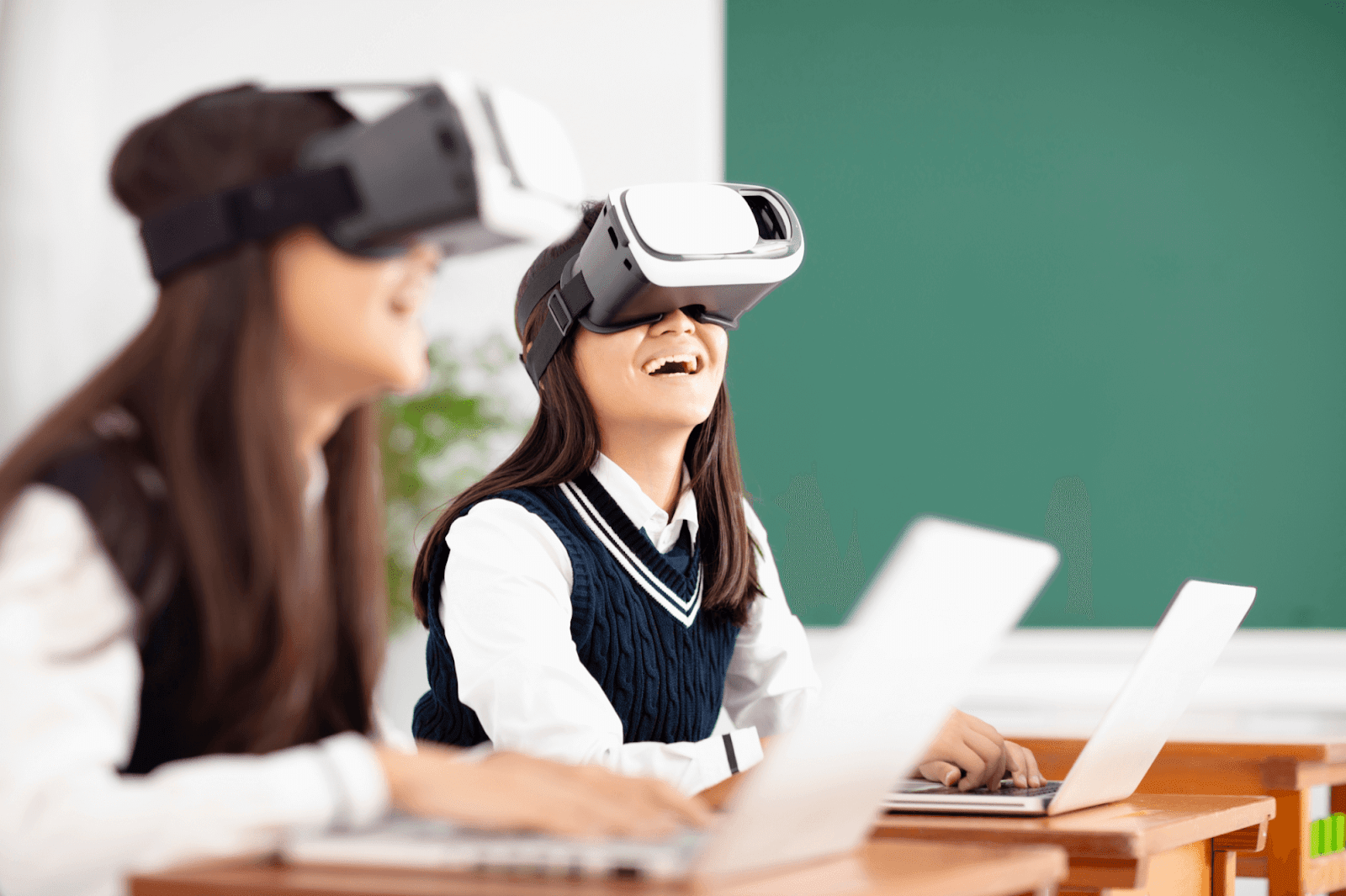
Healthcare augmented reality can be useful for experienced practitioners as well. Every job requires continuous professional development, and the AR environment is a perfect platform for medical specialists to refine their skills and keep up with the latest healthcare advancements.
Increased Precision and Safety in Surgery
Surgeons turn to AR tools in the pursuit of improving accuracy and safety during operations. Overlaying digital information into their field of view helps health professionals make better decisions.
Real-time imaging and 3D visualization is one of the prominent healthcare use cases. Surgeons can see beneath the skin, offering a kind of X-ray vision of the patient’s internal structures. This technology is vital during complex procedures such as spinal surgeries, helping avoid critical areas and ensure the safety of vital organs.
Training for surgeries has also transformed with AR technology. Surgeons can now rehearse complex procedures in a virtual environment to simulate potential scenarios and plan the best course of action. Such preparation significantly reduces errors and guarantees a higher success rate in actual surgeries. For instance, surgeons have the opportunity to practice particularly challenging cardiac surgery numerous times using virtual reality and augmented reality healthcare solutions before the real operation and become ready for any situation.
Enhanced Patient Engagement and Care
Augmented reality in healthcare is reshaping patient education. It lets healthcare providers use AR solutions to give visual explanations, helping patients understand their health conditions and treatment plans more clearly. For example, a doctor can illustrate the impact of a medication on a patient’s body using AR tools, thus providing a deeper understanding and building trust.
Moreover, AR solutions are enhancing the patient experience in healthcare facilities. AR-enabled navigation can guide individuals to the correct department in large hospitals, reducing confusion and saving time. In waiting rooms, AR in healthcare can offer interactive and engaging content, making the wait less tedious and more informative. Such an approach to patient care will make hospital visits less daunting and more user-friendly.
Improved Diagnostic Capabilities
Radiologists can use AR tools to overlay diagnostic images onto a patient’s body to get a more comprehensive view of the internal structures. It aids specialists in making diagnoses more accurately and helps them plan treatment strategies more effectively.
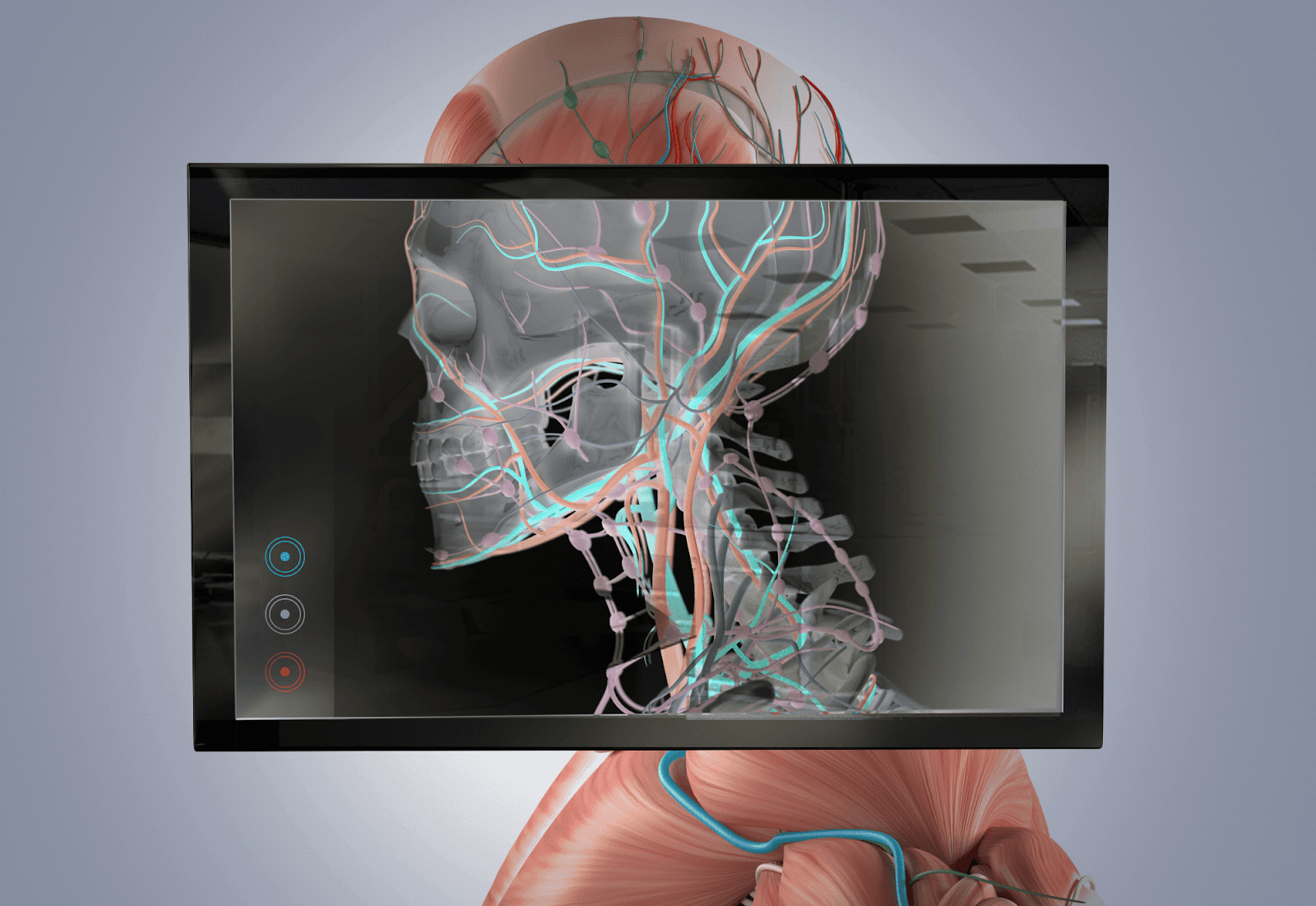
This technology also facilitates remote diagnostics through high-resolution images that can be shared via AR platforms. For instance, a dermatologist can analyze skin conditions from a distance and ensure timely and accurate diagnoses.
Streamlined Workflow and Increased Efficiency
By integrating AR in healthcare systems, medical facilities can optimize workflows, reduce errors, and save valuable time. How? For instance, real-time data and imagery directly overlayed on the patient’s body during surgeries helps surgeons reduce the time spent on referring to monitors or paperwork. This immediate access to vital information can significantly speed up procedures while increasing precision.
On top of that, AR can be a great assistant in effective resource management within your facilities. Through AR-enabled devices, staff can quickly locate equipment and get instant updates on patient status. Thus, it allows your employees to make informed decisions swiftly and coordinate efforts more effectively. What’s more, coupled with Machine Learning, AR can deliver impressive results in terms of efficiency.
Key Applications of AR in Healthcare
Augmented reality is rapidly becoming a transformative force in the healthcare sector, offering innovative solutions and applications that reshape patient care and medical procedures. AR is opening up a world of possibilities. So, how is augmented reality used in healthcare?
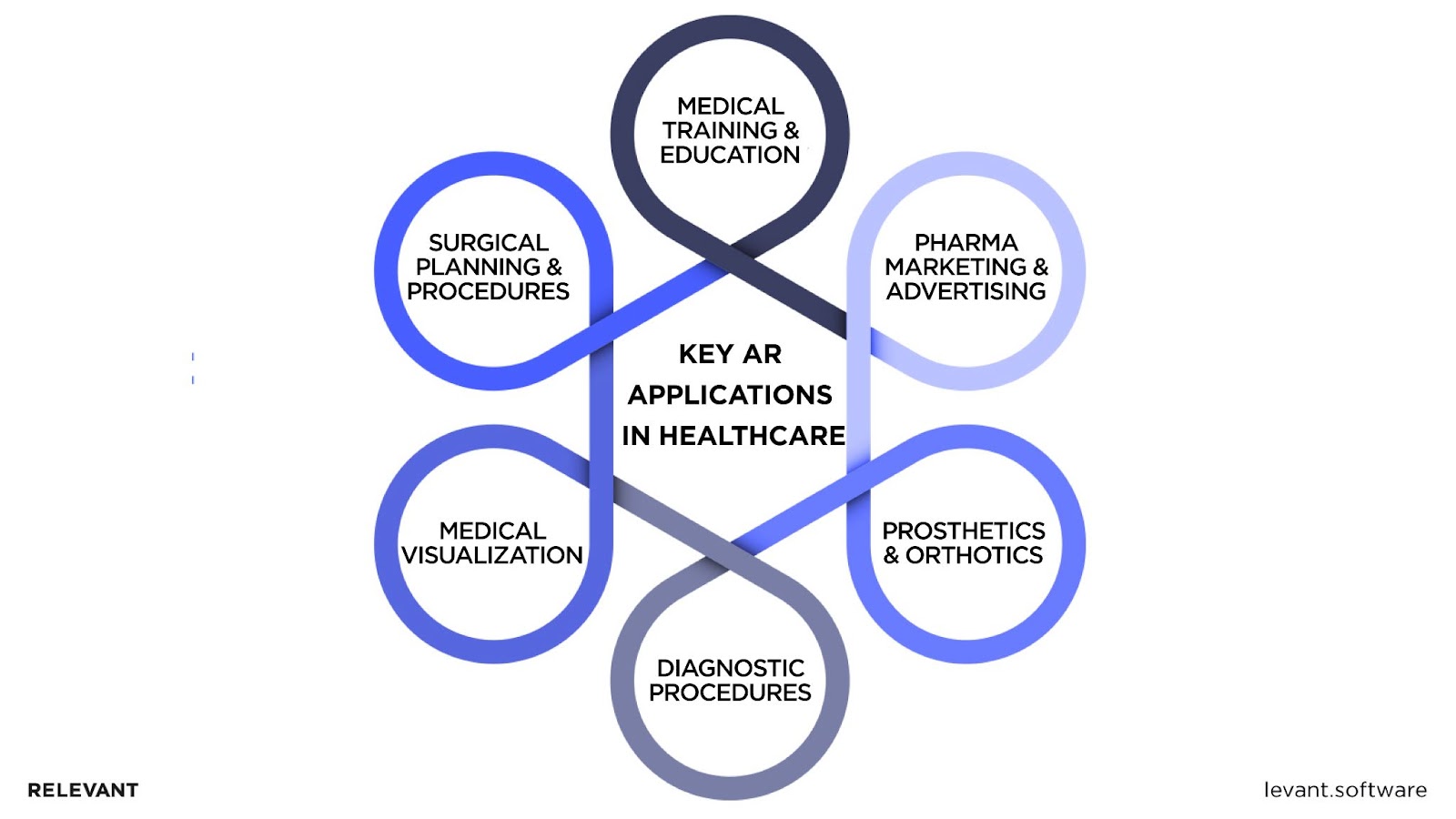
Medical Training and Education
AR apps are at the forefront of creating a rich, interactive, and immersive learning environment for medical students. Its use for anatomy classes allows students to explore the human body in a 3D space, visualizing complex systems and organs in great detail, which fosters a higher retention of the subject matter. AR application is also valuable in studying various diseases as it can visualize the progression of conditions and help students understand the underlying mechanisms at play.
As we already mentioned, AR in healthcare also advances surgical training by creating a risk-free, virtual environment for budding surgeons to practice. It aids surgeons in honing their skills and also prepares them for real-life scenarios. As a result of such interactive practice, they will gain a higher level of proficiency and confidence when they perform surgeries on real patients.
Surgical Planning and Procedures
A prime showcase of augmented reality in healthcare examples is its use in pre-operative planning. Surgeons can visualize the patient’s anatomy in 3D, allowing for a detailed analysis and a strategic approach to the surgery. In fact, AR delivers a detailed roadmap for surgeries involving intricate structures such as the brain or the heart, simplifying the task for surgeons.
Meanwhile, real-time, 3D imagery of the patient’s internals during surgeries will give doctors a dynamic view that goes beyond what the naked eye can see. With such AR help, surgeons can reduce the time spent on the procedure and create a more thorough approach to operations.
Medical Visualization
Augmented reality in the healthcare industry is taking strides, notably enhancing medical visualization, a critical aspect that facilitates better understanding and analysis of medical conditions. The use of AR for visualizing 3D medical imaging from MRI and CT scans is one of those advancements. Medical professionals can now explore these images in a more interactive and detailed manner, which was impossible with traditional 2D images. This kind of visualization is proving instrumental in diagnosing conditions more accurately and planning treatments more effectively.
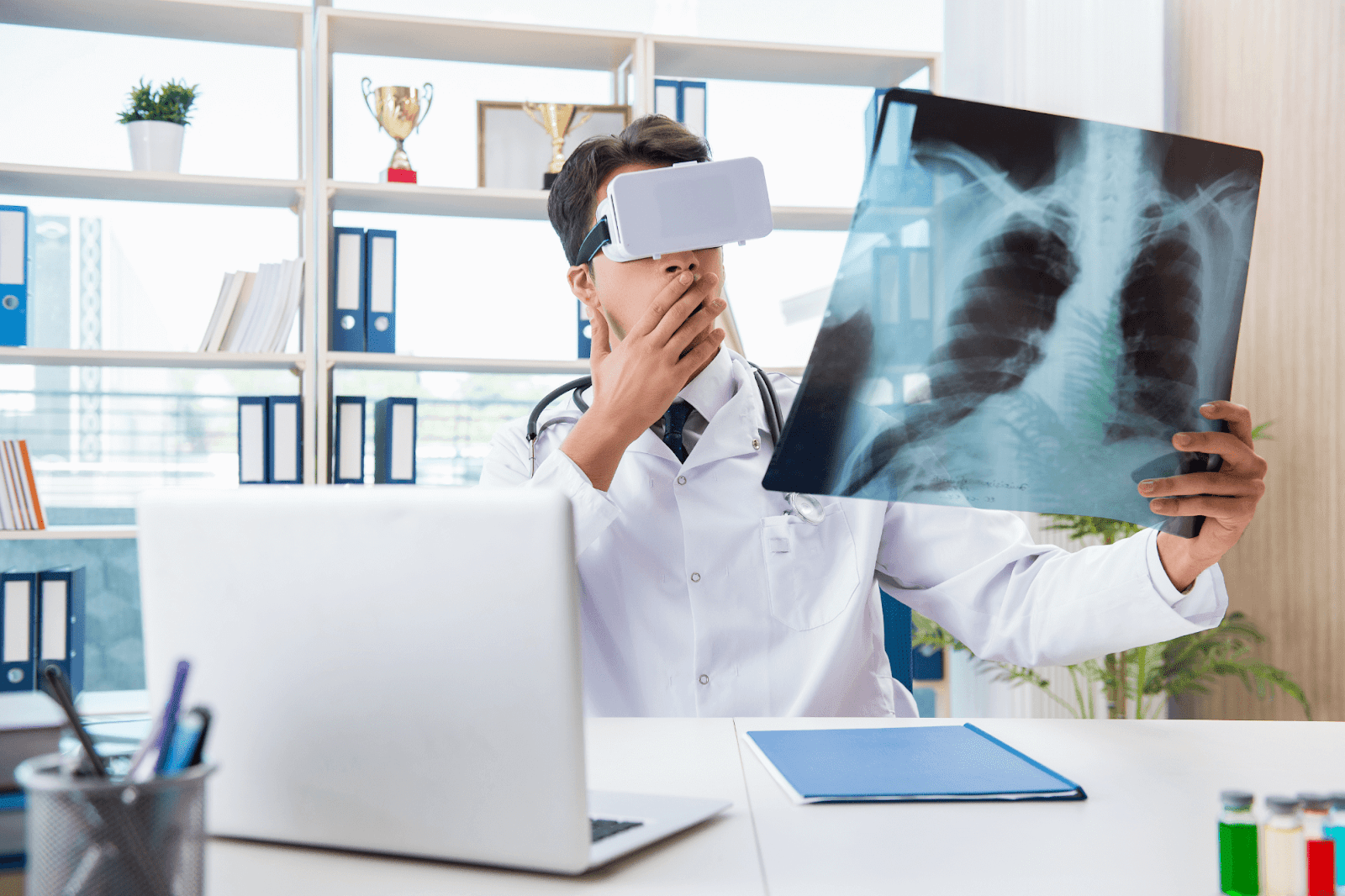
Detailed and augmented medical visualization possible due to AR also helps educate patients. With it, doctors can explain drug effects on the human body and other complex medical conditions to patients in a more tangible way.
Diagnostic Procedures
A primary application of AR in diagnostics is its ability to assist radiologists in interpreting imaging results. By utilizing AR solutions, radiologists can overlay diagnostic images onto a patient’s body, offering a more comprehensive view and allowing for a more precise analysis. Besides radiology, it extends to various other disciplines, including cardiology and neurology, where AR aids in a more detailed and interactive analysis of medical images.
AR is also a great enhancer of remote diagnostic capabilities. Take, for instance, a scenario where a neurologist analyzes a patient’s neurological symptoms through AR-enabled tools that capture detailed data and visual cues. So, doctors can conduct comprehensive patient assessments without the need for physical presence and make precise diagnoses timely.
Prosthetics and Orthotics
AR takes the creation of prosthetic and orthotic devices to new heights, enhancing the quality of life for individuals who rely on these aids. A vivid illustration of augmented reality examples in healthcare is its role in prosthetic design. It enables a dynamic, real-time collaboration of engineers and medical professionals working on visualizing and modifying prosthetic designs. Such close and interactive collaboration will lead to a product tailored to the individual’s unique physiological needs, combining comfort and functionality.
In the orthotics domain, AR is aiding in the development of devices that are more adaptive, intuitive, and in tune with a person’s biomechanics. For instance, it can guide the development of orthotic devices that offer better mobility, lessen discomfort, and align intuitively with the individual’s natural movements.
Pharma Marketing & Advertising
AR brings a fresh and interactive dimension to how products are presented and promoted. For instance, it can transform the traditional patient leaflet into an interactive 3D experience. Imagine a customer pointing their smartphone at a product’s packaging and instantly receiving such information as video demonstrations on how to use the product, testimonials, and detailed product specifications, all presented in an engaging AR format. It promotes a deeper connection with the product and empowers consumers to make informed decisions.
Another AR in healthcare use case in this field is the creation of interactive 3D displays of the products for pharmaceutical exhibitions and conferences. Companies representing their products in such an engaging way will give attendees a chance to explore the products and their features in-depth through a hands-on AR experience. This kind of immersive experience will significantly improve brand recall and build a deeper connection with potential clients.
Challenges of AR in Healthcare
Healthcare professionals and developers find themselves working with this immersive technology on somewhat unfamiliar grounds. Augmented reality in healthcare brings substantial innovations, yet it encounters a series of hurdles that impede its seamless integration. Below, we will examine some difficulties hindering AR from becoming widespread and discuss potential solutions that can help overcome these challenges.
Technical Challenges and Integration Issues
One of the primary concerns revolves around the seamless integration of digital information into existing healthcare systems. For instance, the smooth functioning of AR technology in surgery requires high-precision tools and real-time data analytics, which demands substantial investments in technology and training. Moreover, the daily surge in data volume presents a significant challenge, requiring robust algorithms capable of managing complex data while ensuring the security and privacy of sensitive information.
Data Security and Privacy Concerns
The growing use of AR in healthcare increases the risk of data breaches and privacy violations. When integrating AR and VR in healthcare, you should understand that it requires collecting and handling sensitive patient data while opening new security vulnerabilities. It can become an alluring target for cyber-attackers. For instance, a security loophole in an AR solution could allow a hacker to access and misuse a patient’s confidential health records, with all that it implies.
There also exists the ever-present concern of unauthorized data sharing with third-party companies, raising serious privacy issues. It is imperative for healthcare institutions to implement strict data security measures and use data encryption to create a safe environment. The road ahead demands a thorough approach to data governance and avoidance of data mishandling to embrace the full potential of AR technology.
Ethical Considerations
The adoption of AR in healthcare raises questions about the equitable distribution of such advancements. For instance, many think that only high-income patients in well-funded hospitals will have access to AR-enhanced healthcare, which can widen the existing healthcare disparity.
The surge in AR’s role in diagnostics and medical training also sparks a debate on the balance between technology reliance and human expertise. While AR offers unparalleled visualization and analysis capabilities, an overreliance could potentially undermine the intuitive skills and judgment healthcare professionals hone over years of practice. It becomes imperative, then, to initiate a dialogue on the ethical deployment of AR to ensure that it serves as a tool for good while upholding the highest standards of ethical practice.
AR in healthcare: Bottom Line
Based on the anticipated market expansion and the development pace of healthcare AR apps, it is evident that there is a substantial runway for growth and innovation. The future of AR in healthcare is expanding steadily, witnessing the continuous progress of apps that help medical professionals do their jobs better. It promises a paradigm shift to digitalized processes, visualization of complex data, and efficiency improvement.
At Relevant Software, we can help you build the right solution that harnesses the full potential of AR in healthcare. Our team of healthcare IT consulting experts will tell you about all the nuances of this technology and the best ways to exploit it for your project. Share your project vision with us, and we will develop software that resonates with your needs and demands.



